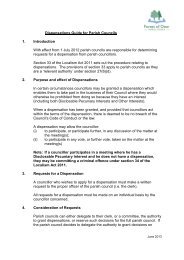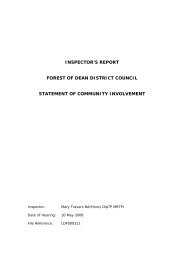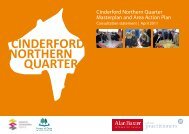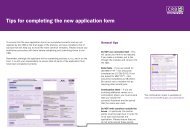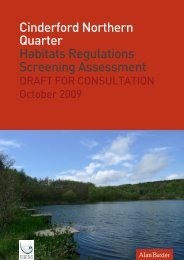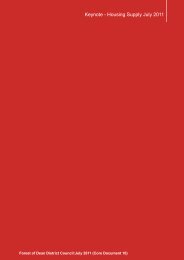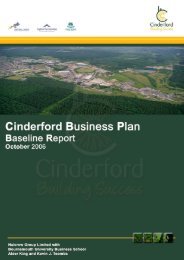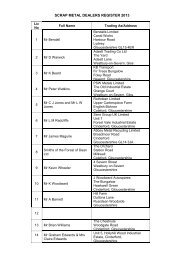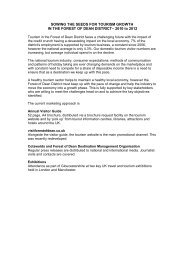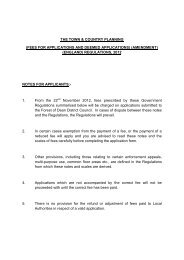Case Studies Courtauld Commitment - Forest of Dean District Council
Case Studies Courtauld Commitment - Forest of Dean District Council
Case Studies Courtauld Commitment - Forest of Dean District Council
Create successful ePaper yourself
Turn your PDF publications into a flip-book with our unique Google optimized e-Paper software.
<strong>Case</strong> <strong>Studies</strong><br />
<strong>Courtauld</strong> <strong>Commitment</strong><br />
Examples <strong>of</strong> household packaging optimisation and food waste.<br />
Please address any enquiries to either the main Press Office contact for each company, if<br />
mentioned, or directly to WRAP at retail@wrap.org.uk.<br />
Further information about the <strong>Courtauld</strong> <strong>Commitment</strong> can be found at<br />
www.wrap.org.uk/courtauld.<br />
Date: 04 August 2009
WRAP helps individuals, businesses and<br />
local authorities to reduce waste and<br />
recycle more, making better use <strong>of</strong><br />
resources and helping to tackle climate<br />
change.<br />
Front cover photography: Examples <strong>of</strong> products sold by some <strong>of</strong> the <strong>Courtauld</strong> <strong>Commitment</strong> signatories.<br />
While steps have been taken to ensure its accuracy, WRAP cannot accept responsibility or be held liable to any person for any loss or damage arising out <strong>of</strong> or in<br />
connection with this information being inaccurate, incomplete or misleading.<br />
This material is copyrighted. It may be reproduced free <strong>of</strong> charge subject to the material being accurate and not used in a misleading context. The source <strong>of</strong> the material<br />
must be identified and the copyright status acknowledged. This material must not be used to endorse or used to suggest WRAP's endorsement <strong>of</strong> a commercial product<br />
or service. For more detail, please refer to our Terms & Conditions on our website - www.wrap.org.uk.
Contents<br />
1.0 Asda Wal*Mart ......................................................................................................................... 5<br />
1.1 <strong>Case</strong> Study 1: Glass Containers (packaging)............................................................................5<br />
1.2 <strong>Case</strong> Study 2: Sandwiches – Café Range (packaging/food waste).............................................5<br />
2.0 Boots UK Ltd............................................................................................................................. 6<br />
2.1 <strong>Case</strong> Study: Gifts – Botanics Essential (packaging) ..................................................................6<br />
3.0 Britvic S<strong>of</strong>t Drinks Ltd .............................................................................................................. 7<br />
3.1 <strong>Case</strong> Study: Plastic Bottles – Robinsons (packaging)................................................................7<br />
4.0 Burton’s Foods ......................................................................................................................... 8<br />
5.0 Cadbury .................................................................................................................................... 9<br />
5.1 <strong>Case</strong> Study: Confectionery - Easter Eggs (packaging) ..............................................................9<br />
6.0 Coca Cola Enterprises Ltd.......................................................................................................10<br />
6.1 <strong>Case</strong> Study 1: Glass Bottles – 330ml Range (packaging) .......................................................10<br />
6.2 <strong>Case</strong> Study 2: Aluminium Drink Cans (packaging)..................................................................11<br />
7.0 The Co-operative Group ......................................................................................................... 12<br />
7.1 <strong>Case</strong> Study: Glass Bottles – Whisky (packaging) * .................................................................12<br />
8.0 Dairy Crest ............................................................................................................................. 13<br />
8.1 <strong>Case</strong> Study 1: Plastic Bottles – Milk (packaging) ....................................................................13<br />
8.2 <strong>Case</strong> Study 2: Plastic Container - Milk in a Bag (packaging)...................................................13<br />
9.0 Danone Waters (UK & Ireland Ltd) ........................................................................................ 14<br />
9.1 <strong>Case</strong> Study: Plastic Bottles (packaging).................................................................................14<br />
10.0 Duchy Originals ...................................................................................................................... 15<br />
10.1 <strong>Case</strong> Study: Confectionery – Chocolate Bezants (packaging) .................................................15<br />
11.0 Greencore Group UK............................................................................................................... 16<br />
11.1 <strong>Case</strong> Study 1: Plastic Packaging - Yorkshire Puddings (packaging)..........................................16<br />
11.2 <strong>Case</strong> Study 2: Plastic Bottles (packaging) * #........................................................................16<br />
12.0 H J Heinz Company Limited.................................................................................................... 17<br />
12.1 <strong>Case</strong> Study: Plastic Bottles – Tomato Ketchup (packaging).....................................................17<br />
13.0 Iceland ................................................................................................................................... 18<br />
14.0 Kellogg’s................................................................................................................................. 19<br />
15.0 Marks & Spencer .................................................................................................................... 20<br />
15.1 <strong>Case</strong> Study: Plastic Meat Pack (packaging/food waste) ..........................................................20<br />
15.2 <strong>Case</strong> Study 2: Confectionery Easter Eggs (packaging)............................................................21<br />
16.0 Mars........................................................................................................................................ 22<br />
16.1 <strong>Case</strong> Study 1: Glass Containers (packaging).........................................................................22<br />
16.2 <strong>Case</strong> Study 2: Confectionery Plastic Container – Celebrations (packaging)...............................22<br />
16.3 <strong>Case</strong> Study 3: Confectionery Easter Eggs (packaging)............................................................23<br />
17.0 Morrisons ............................................................................................................................... 24<br />
17.1 <strong>Case</strong> Study: Carton Board Packaging - ‘Prepared for You’ (packaging) ...................................24<br />
18.0 Müller Dairy (UK) Limited ...................................................................................................... 25<br />
18.1 <strong>Case</strong> Study: Plastic Yogurt Pots (packaging)..........................................................................25<br />
19.0 Musgrave................................................................................................................................ 26<br />
20.0 Nestlé UK Ltd.......................................................................................................................... 27<br />
20.1 <strong>Case</strong> Study 1: Confectionery Tin - Quality Street (packaging) .................................................27<br />
20.2 <strong>Case</strong> Study 2: Confectionery - Easter Eggs (packaging) .........................................................28<br />
21.0 Northern Foods ...................................................................................................................... 30<br />
21.1 <strong>Case</strong> Study: Carton Board - Pizza Box (packaging).................................................................30<br />
22.0 Procter & Gamble ................................................................................................................... 31<br />
22.1 <strong>Case</strong> Study: Plastic Container - Ariel Excel Gel (packaging) ....................................................31<br />
23.0 Robert McBride Ltd ................................................................................................................ 32<br />
23.1 <strong>Case</strong> Study: Plastic Bottle - Washing Up Liquid (packaging)....................................................32<br />
24.0 Robert Wiseman Dairies......................................................................................................... 33<br />
24.1 <strong>Case</strong> Study 1: Plastic Bottle – Milk Bottle Caps (packaging) ....................................................33<br />
25.0 Sainsbury’s ............................................................................................................................. 34<br />
25.1 <strong>Case</strong> Study 1: Plastic Packaging - Fresh Salmon Range (packaging)........................................34<br />
25.2 <strong>Case</strong> Study 2: Recycled Plastic Bottles – Taste the Difference Chilled Juices (packaging)..........34<br />
25.3 <strong>Case</strong> study 3: Plastic Packaging – Own Label Smoked Salmon (packaging) * ..........................34<br />
<strong>Courtauld</strong> <strong>Commitment</strong> 3
25.4 <strong>Case</strong> Study 4: Food Waste ...................................................................................................34<br />
25.5 <strong>Case</strong> Study: Confectionery – Easter Eggs (packaging)............................................................35<br />
26.0 Somerfield .............................................................................................................................. 36<br />
26.1 <strong>Case</strong> Study: Sandwiches – Best Ever Range (packaging).......................................................36<br />
27.0 Tesco ...................................................................................................................................... 37<br />
27.1 <strong>Case</strong> Study: Plastic Bottle – Double Concentrated Squash (packaging)....................................37<br />
28.0 United Biscuits ....................................................................................................................... 38<br />
28.1 <strong>Case</strong> Study 1: Snacks - Hula Hoops (packaging)....................................................................38<br />
28.2 <strong>Case</strong> Study 2: Snacks - Jacob’s Biscuits for Cheese (packaging) .............................................38<br />
29.0 Waitrose ................................................................................................................................. 40<br />
29.1 <strong>Case</strong> Study 1: Plastic Packaging - Salad and Leaf (packaging) ................................................40<br />
29.2 <strong>Case</strong> Study 2: Plastic Packaging - Milk Pouch and Jug (packaging) # ......................................40<br />
29.3 <strong>Case</strong> Study 3: Food Waste ...................................................................................................41<br />
30.0 Warburtons ............................................................................................................................ 43<br />
30.1 <strong>Case</strong> Study: New 600g mid sized loaf range (packaging/food waste) ......................................43<br />
31.0 Young’s Seafood..................................................................................................................... 44<br />
31.1 <strong>Case</strong> Study: Plastic Packaging - Lightly Smoked Salmon Fillets (packaging).............................44<br />
Note: These are UK examples but some have a particular connection with Scotland (*) or Wales (#)<br />
as marked in the <strong>Case</strong> Study headers.<br />
<strong>Courtauld</strong> <strong>Commitment</strong> 4
1.0 Asda Wal*Mart<br />
Asda has achieved a 20% reduction in its own-label packaging, with a particular focus on cutting the amount <strong>of</strong><br />
glass used.<br />
1.1 <strong>Case</strong> Study 1: Glass Containers (packaging)<br />
As a key partner in WRAP’s GlassRite project, Asda has worked with suppliers, advisory bodies and academics to<br />
prove that lightweight glass packaging can be delivered to market without affecting quality or sales. It has since<br />
reduced the weight <strong>of</strong> glass packaging for sauces, pickles, spices, c<strong>of</strong>fee and wine bottles.<br />
These initiatives have achieved an overall glass reduction <strong>of</strong> 2,871 tonnes compared to 2005.<br />
“Asda Wal*Mart values its relationship with WRAP and the changes we have already put in place are making a big<br />
difference. By working closely with the programme on the <strong>Courtauld</strong> <strong>Commitment</strong> and the GlassRite project, we<br />
will achieve the massive target we have set ourselves: to reduce packaging by 25% the end <strong>of</strong> 2008."<br />
Julian Walker-Palin, Head <strong>of</strong> Corporate Policy for Sustainability & Ethics<br />
1.2 <strong>Case</strong> Study 2: Sandwiches – Café Range (packaging/food waste)<br />
Asda has successfully launched a new pack for their Café Sandwich range which is 56% lighter in weight. The<br />
new pack weighs just 7g, which is 9g lighter than the original 16g pack.<br />
They have done this by reducing the cardboard outer sleeve and using a plastic film. The flow-wrap film<br />
maintains the freshness <strong>of</strong> the product for longer because it has a better seal and this can help to reduce food<br />
waste.<br />
The new packaging shows more <strong>of</strong> the sandwich and its filling to the consumer and the new look maintains brand<br />
integrity. Packaging recycling information is provided on the back <strong>of</strong> the pack.<br />
The smarter packaging leads to greater transport efficiencies as more sandwich packs can be loaded onto<br />
delivery vehicles.<br />
“We are very pleased with the reductions we have delivered for our Café Sandwich range. This is one <strong>of</strong> the<br />
many packaging reduction initiatives we have landed in 2008. ”<br />
Greg Alder, Packaging Technical Manager, Asda<br />
Before After<br />
<strong>Courtauld</strong> <strong>Commitment</strong> 5
2.0 Boots UK Ltd<br />
Boots’ strategy for Christmas 2008 is to reduce the overall amount <strong>of</strong> gift packaging used, make recycling easier<br />
for the consumer and promote reusable containers. All Christmas 2007 gifts were reviewed with these aims in<br />
mind.<br />
2.1 <strong>Case</strong> Study: Gifts – Botanics Essential (packaging)<br />
For example, the Botanics Essential gift set packaging has been changed from a large rigid box with a vacuum<br />
wrapping and sleeve to a re-useable tin with a card sleeve. The tin is designed to hold all contents securely, thus<br />
removing the need for additional packaging to keep the products in place, while the card sleeve contains 80%<br />
recycled material.<br />
The 2008 set therefore uses a fraction <strong>of</strong> the packaging <strong>of</strong> the 2007 set, even through the contents remain the<br />
same. The total weight has been cut from 477.8 grams to just 23 grams, generating savings <strong>of</strong> almost 453 grams<br />
per set. Furthermore, all elements can be easily recycled and the environmental impact <strong>of</strong> transit packaging and<br />
transportation has also been reduced due to the gift’s smaller footprint.<br />
Boots is now implementing similar changes across a wide range <strong>of</strong> gifts, achieving typical savings <strong>of</strong> 5 tonnes <strong>of</strong><br />
packaging per product line.<br />
“Packaging optimisation has been a key part <strong>of</strong> Boots’ strategy to improve the sustainability <strong>of</strong> all our products.<br />
We consider the entire product journey, from design through raw material sourcing, production and retailing to<br />
consumer use and end <strong>of</strong> life. Our aim is to continue to develop products that have the best environmental and<br />
ethical pr<strong>of</strong>ile.<br />
About the <strong>Courtauld</strong> <strong>Commitment</strong>:<br />
“Working in partnership with WRAP through the <strong>Courtauld</strong> <strong>Commitment</strong> has enabled us to ensure our approach is<br />
aligned with national strategy. This means we can collectively tackle the challenge <strong>of</strong> developing a truly holistic<br />
approach to sustainable production and consumption.”<br />
Andrew Jenkins, Sustainable Development Manager – Products, Boots UK Ltd.<br />
Press <strong>of</strong>fice contact: Fiona Lakin - 0115 959 2901<br />
The old and new Botanics Essentials gift sets<br />
<strong>Courtauld</strong> <strong>Commitment</strong> 6
3.0 Britvic S<strong>of</strong>t Drinks Ltd<br />
Over the past two years Britvic has invested more than £5 million in making changes to its Robinsons brand to<br />
reduce the weight <strong>of</strong> packaging used and improve its environmental impact.<br />
3.1 <strong>Case</strong> Study: Plastic Bottles – Robinsons (packaging)<br />
This has included redesigning the Robinsons 1 litre bottle to remove 1.5 grams <strong>of</strong> weight and reduce the height<br />
by 1.5 mm, saving 250 tonnes <strong>of</strong> plastic. Britvic was also able to then reduce the amount <strong>of</strong> cardboard used in<br />
the trays displaying the bottles in store by 5%, saving 50 tonnes <strong>of</strong> cardboard per year.<br />
The redesign <strong>of</strong> the Robinsons large packs (2, 3 and 4 litre) enabled the removal <strong>of</strong> between 8 and 63 grams <strong>of</strong><br />
plastic per bottle, totalling over 800 tonnes <strong>of</strong> plastic saved per year.<br />
The company did not stop there and also reduced the weight <strong>of</strong> the bottle and cap used for its Robinsons Fruit<br />
Spring range. This cut overall packaging by a third and saved an additional 228 tonnes per year.<br />
Britvic is now about to roll out 1 litre bottles with a further weight reduction <strong>of</strong> 2 grams. This change will save<br />
330 tonnes <strong>of</strong> plastic per year, as well as cutting energy needs by 5% and generating further carbon reductions.<br />
In total these measures have reduced the amount <strong>of</strong> packaging used in Robinsons products by over 1,670 tonnes<br />
per year. They have also cut the number <strong>of</strong> lorry loads needed to transport the products; in fact, the new 1 litre<br />
bottle design means 25% more cases <strong>of</strong> Robinsons can be loaded onto pallets, cutting lorry loads by 1,500 per<br />
year and saving approximately 350 tonnes <strong>of</strong> carbon emissions.<br />
About the <strong>Courtauld</strong> <strong>Commitment</strong>:<br />
“Britvic has a long-standing responsibility to the environment and for many years we have had Board-level<br />
commitments to improve energy efficiency and reduce waste from our operations. In 2007 we became the first<br />
s<strong>of</strong>t drinks company to sign up to the <strong>Courtauld</strong> <strong>Commitment</strong>, and working with WRAP in this way means we can<br />
continue our waste reduction work at our own sites and through the packaging sent to our customers and<br />
consumers.”<br />
Graham Dale, Head <strong>of</strong> Quality, Safety and Environment, Britvic S<strong>of</strong>t Drinks Ltd<br />
Press <strong>of</strong>fice contact: Susan Turner - 01245 261871<br />
<strong>Courtauld</strong> <strong>Commitment</strong> 7
4.0 Burton’s Foods<br />
“Burton’s Foods recognises the significant impact sustainable efforts can have on the environment. We are<br />
committed to behaving responsibly to help sustain the integrity and biodiversity <strong>of</strong> the local, regional and global<br />
eco-system.<br />
“Through our partnership with WRAP, and the <strong>Courtauld</strong> Agreement, we are confident that we can deliver our<br />
pledges to increase the use <strong>of</strong> recycled packaging and cut the relative amount <strong>of</strong> packaging we use.“<br />
Jo Shears, Strategic Project Manager, Burton’s Foods<br />
Press <strong>of</strong>fice contact: 0207 908 6583<br />
<strong>Courtauld</strong> <strong>Commitment</strong> 8
5.0 Cadbury<br />
5.1 <strong>Case</strong> Study: Confectionery - Easter Eggs (packaging)<br />
As a leading member <strong>of</strong> a resource efficiency initiative set up by industry called the Seasonal Confectionery<br />
Working Group (SCWG), Cadbury has made further steps towards reducing its environmental impact in 2009 by<br />
continuing to reduce packaging around its boxed Easter Eggs.<br />
The company has been working with WRAP and other suppliers to deliver a minimum 25% reduction in packaging<br />
across medium shell eggs, resulting in 220 tonnes less plastic being used, 250 tonnes <strong>of</strong> cartonboard and 90<br />
tonnes less transit / display packaging.<br />
In addition, Cadbury has also made significant savings on its large shell egg range, achieving a 30% reduction in<br />
packaging, eliminating 108 tonnes <strong>of</strong> plastic, 65 tonnes <strong>of</strong> cartonboard and corrugated cardboard by 44 tonnes.<br />
The ’Eco eggs’ range, originally launched in 2008, has also been expanded and features refreshed designs for the<br />
2009 season. Eco Eggs are unboxed, and include ‘Treasure Eggs’ - milk chocolate shell eggs containing chocolate<br />
treats inside the egg - and ‘Eggheads’; hollow milk chocolate shell eggs featuring six different designs on the foil.<br />
The Cadbury Eco Eggs range won the best packaging award at the Green Awards 2008.<br />
“Cadbury is committed to reducing its impact on the environment, which reinforces the company’s ability to meet<br />
consumer demand for more environmental Easter Egg packaging. We are very pleased with the reductions that<br />
we have made in both medium and large boxed Easter Egg packaging and will continue to work with suppliers to<br />
improve this further in the future.”<br />
Doug Hughes, S&T, Packaging Development and Commercialisation Manager at Cadbury<br />
About the <strong>Courtauld</strong> <strong>Commitment</strong>:<br />
“The <strong>Courtauld</strong> <strong>Commitment</strong> is a strong foundation to drive an absolute reduction in packaging and must be seen<br />
as only the starting point to developing a truly sustainable supply chain.<br />
“Cadbury’s commitment to the environment is at the heart <strong>of</strong> its workplace culture and the company has worked<br />
hard for the past 15 years to reduce its impact on the environment. Working with WRAP and participating in the<br />
independent UK waste forum has allowed Cadbury to further understand the specific role packaging plays within<br />
the complicated UK waste strategy. It also provides an opportunity to connect with organisations that have<br />
similar beliefs and challenges.”<br />
Doug Hughes, S&T, Packaging Development and Commercialisation Manager, Cadbury<br />
<strong>Courtauld</strong> <strong>Commitment</strong> 9
6.0 Coca Cola Enterprises Ltd<br />
6.1 <strong>Case</strong> Study 1: Glass Bottles – 330ml Range (packaging)<br />
Coca-Cola Enterprises Ltd (CCE) has reduced the weight <strong>of</strong> its iconic 330ml glass Contour Bottle by a fifth, an<br />
initiative which will save more than 3,500 tonnes <strong>of</strong> glass and an estimated 2,200 tonnes <strong>of</strong> CO2 per year.<br />
All new 330ml glass bottles <strong>of</strong> Coca-Cola, diet Coke and Coca-Cola Zero have been reduced from 263g to 210g<br />
using new specifications known as the ‘Ultra’ design. This retains the bottles’ trademark dimensions and<br />
maintains quality and strength while significantly improving environmental performance.<br />
The company has also worked with its suppliers and WRAP to reduce the weight <strong>of</strong> its 500ml PET bottles to just<br />
24g, which will cut the amount <strong>of</strong> PET plastic used by 700 tonnes per year. This included redesigning the preform<br />
bottle from which other bottles are produced and modifying CCE’s manufacturing sites in Sidcup and<br />
Wakefield.<br />
“Our work to reduce the weight <strong>of</strong> our bottles demonstrates how packaging can be optimised without affecting<br />
customer perception, product quality or brand values.<br />
“We are always looking for ways to reduce the impact <strong>of</strong> our business on the environment and are prepared to<br />
adapt even our most precious assets, including the Contour Bottle.<br />
“Our partnership with WRAP as part <strong>of</strong> the <strong>Courtauld</strong> <strong>Commitment</strong> is a key part <strong>of</strong> this and we look forward to<br />
continuing our work with the team to seek further sustainable packaging solutions.”<br />
Erika Coghlan, VP Corporate Affairs, CCE<br />
The old and new Contour bottles<br />
<strong>Courtauld</strong> <strong>Commitment</strong> 10
6.2 <strong>Case</strong> Study 2: Aluminium Drink Cans (packaging)<br />
Coca-Cola Enterprises Ltd (CCE) has reduced the weight <strong>of</strong> its aluminium drinks cans by 5%, leading to significant<br />
raw material and carbon savings.<br />
CCE led the technical development <strong>of</strong> this new can, working with project partners WRAP and Beverage Can<br />
Makers Europe (BCME), to extensively test the design at its UK manufacturing sites. The project represents the<br />
first time within the EU that the body <strong>of</strong> a can, rather than the base alone, has been reduced in weight.<br />
The new can body target width is only 0.097mm wide – about the width <strong>of</strong> a human hair. Around 6.5 billion <strong>of</strong><br />
the cans have already been distributed, with further implementation planned across Europe in 2009. Detailed<br />
scientific analysis carried out during development means that the lighter cans remain as robust as ever, with no<br />
compromise on packaging quality.<br />
This lighter design will save 15,000 tonnes <strong>of</strong> aluminium across the EU every year, with an average recycled<br />
content <strong>of</strong> 50%; this is a CO 2 reduction <strong>of</strong> approximately 88,000 tonnes – equivalent to removing nearly 28,000<br />
cars from the road.<br />
“At CCE we are committed to constantly improving the sustainability <strong>of</strong> our business and this work has changed<br />
the design <strong>of</strong> aluminium drinks cans forever. The project is now delivering a significant reduction to the carbon<br />
footprint <strong>of</strong> our business across Europe and we are also working to identify further packaging improvements.”<br />
Hubert Patricot, European President, Coca-Cola Enterprises Ltd<br />
<strong>Courtauld</strong> <strong>Commitment</strong> 11
7.0 The Co-operative Group<br />
7.1 <strong>Case</strong> Study: Glass Bottles – Whisky (packaging) *<br />
The Co-operative Group has made significant progress on reducing their environmental impact and packaging<br />
waste and one example <strong>of</strong> their efforts can be found in the design <strong>of</strong> their lightweight whisky bottle.<br />
Since April 2007, The Co-operative has been using what is believed to be the world’s lightest 70cl spirits bottle to<br />
package their own-label whisky.<br />
The bottle is designed to reduce manufacturing costs, cut carbon emissions and minimise the amount <strong>of</strong> glass<br />
being used in packaging. It is the first commercially available 70cl spirits bottle to break the 300 gram weight<br />
barrier.<br />
About the <strong>Courtauld</strong> <strong>Commitment</strong>:<br />
“Being involved with WRAP and the <strong>Courtauld</strong> <strong>Commitment</strong> has been a great way <strong>of</strong> focussing our environmental<br />
efforts - their guidance and support has been extremely valuable to us. Our involvement in the project and<br />
particularly working on the lightweight glass bottles proves that it is possible for packaging to be resource<br />
efficient, without compromising performance or consumer appeal.”<br />
Iain Ferguson, Commercial Packaging Manager, The Co-operative Group<br />
This bottle, manufactured by Ardagh Glass, is believed<br />
to be the world’s lightest 70cl glass spirits bottle<br />
<strong>Courtauld</strong> <strong>Commitment</strong> 12
8.0 Dairy Crest<br />
8.1 <strong>Case</strong> Study 1: Plastic Bottles – Milk (packaging)<br />
Dairy Crest started by supplying Marks & Spencer with milk in HDPE bottles containing 10% recycled plastic, then<br />
the company went on to develop a prototype handle-free plastic milk bottle.<br />
8.2 <strong>Case</strong> Study 2: Plastic Container - Milk in a Bag (packaging)<br />
An innovative low waste milk packaging alternative to plastic bottles and tetra paks developed by Dairy Crest was<br />
rolled out by Sainsbury’s. “Milk in a bag” is a system where milk is supplied in a recyclable bag, which works with<br />
a specially designed reusable jug. The bags are made from very strong low-density plastic material and have<br />
undergone extensive testing to ensure their durability. The milk bag fits within the reusable jug – JUGIT - which<br />
contains a spike that pierces the bag, forms a no-leak seal, and delivers milk through the spout.<br />
About the <strong>Courtauld</strong> <strong>Commitment</strong>:<br />
“We demonstrated our commitment to finding a more environmentally friendly solution to the problem <strong>of</strong><br />
packaging waste by signing the <strong>Courtauld</strong> <strong>Commitment</strong> in 2007. Since then the innovations that we have<br />
developed show that we are prepared to continue, in partnership with our retail customers, to strive to find<br />
solutions to help us meet the targets set by the <strong>Courtauld</strong> <strong>Commitment</strong> for 2010.”<br />
Mark Allen, Dairy Crest, CEO, Dairy Crest<br />
<strong>Courtauld</strong> <strong>Commitment</strong> 13
9.0 Danone Waters (UK & Ireland Ltd)<br />
Reducing the environmental impact <strong>of</strong> packaging is a top priority for Danone Waters UK Ltd.<br />
9.1 <strong>Case</strong> Study: Plastic Bottles (packaging)<br />
Danone has introduced recycled PET (rPET) plastic bottles into the UK in 2008. Danone is also reducing the<br />
amount <strong>of</strong> PET packaging reaching consumers and is targeting an additional 10% reduction in plastic packaging<br />
by the year 2010.<br />
Historical reductions in packaging <strong>of</strong> 30% and other measures have cut the carbon footprint <strong>of</strong> Evian and Volvic<br />
waters, with an overall 7% reduction in CO2 emissions since 2005. An additional 5% reduction has been set as a<br />
target for the end <strong>of</strong> 2008.<br />
“We are committed to proactively managing and lowering our environmental footprint so we can become more<br />
environmentally friendly as our business grows. As a signatory <strong>of</strong> the <strong>Courtauld</strong> <strong>Commitment</strong>, we strive to reduce<br />
packaging and invest in initiatives that cut packaging waste.”<br />
Louise Coupe, DWUK Sustainability Manager, Danone Waters<br />
<strong>Courtauld</strong> <strong>Commitment</strong> 14
10.0 Duchy Originals<br />
10.1 <strong>Case</strong> Study: Confectionery – Chocolate Bezants (packaging)<br />
Duchy Originals has introduced a new packaging format for its Chocolate Bezants, which replace the company’s<br />
Chocolate Thins product.<br />
By using a folding box design rather than the former box and lid, the company has reduced the weight <strong>of</strong> the<br />
packaging from 68g for 200g <strong>of</strong> product to 26g for 160g <strong>of</strong> product, achieving a 48 per cent weight for weight<br />
saving and associated savings in carbon.<br />
Furthermore, the new design uses carton board which is certified by the <strong>Forest</strong>ry Stewardship <strong>Council</strong> (FSC),<br />
ensuring that the raw materials are sourced from sustainable timber supplies only.<br />
About the <strong>Courtauld</strong> <strong>Commitment</strong>:<br />
“Duchy Originals is an active signatory to the <strong>Courtauld</strong> <strong>Commitment</strong> with work underway to optimise packaging<br />
across our product ranges in line with our Good Food Charter. We are currently trialling a variety <strong>of</strong> different<br />
packaging formats, the fruits <strong>of</strong> which will be brought to market over the coming months.<br />
“We take our responsibilities as a sustainable brand very seriously in terms <strong>of</strong> identifying ways to reduce overall<br />
packaging weight, as well as considering transport efficiencies and lowering our carbon impact.”<br />
Tim Appleton, Group Technical Manager, Duchy Originals<br />
Before<br />
Chocolate Thins (200g product)<br />
After<br />
Chocolate Bezants (160g product)<br />
<strong>Courtauld</strong> <strong>Commitment</strong> 15
11.0 Greencore Group UK<br />
Greencore has made a number <strong>of</strong> changes in an effort to reduce its packaging.<br />
11.1 <strong>Case</strong> Study 1: Plastic Packaging - Yorkshire Puddings (packaging)<br />
One example is its reduction <strong>of</strong> plastic packaging for a range <strong>of</strong> Yorkshire pudding products produced at its<br />
Frozen Foods site in Leeds.<br />
The Yorkshire puddings were previously packed in multiple plastic trays inside bags, but are now being packaged<br />
using new “form and fill” technology, whereby products are placed loose in film bags. This new packaging<br />
method allows extra flexibility without compromising protection. A significant benefit is that more products can fit<br />
on each pallet – helping to reduce the amount <strong>of</strong> transport needed and the associated carbon emissions.<br />
By changing the way the Yorkshire puddings are packed, Greencore Frozen Foods has reduced the pack weight <strong>of</strong><br />
five different products by an average <strong>of</strong> nearly 70% during 2007, saving 115 tonnes <strong>of</strong> plastic from potential<br />
landfill.<br />
The plastic tray has been removed and the outer bag is smaller<br />
11.2 <strong>Case</strong> Study 2: Plastic Bottles (packaging) * #<br />
Greencore Group has two water bottling plants in the UK – one in Scotland and one in Wales. Both these plants<br />
have reduced the weight <strong>of</strong> their plastic ‘pre-form’ bottles – this is the test tube-shaped form from which the<br />
bottle is then blown.<br />
Last year in Scotland these reductions amounted to approximately 110 tonnes <strong>of</strong> PET material, with no loss <strong>of</strong><br />
quality or with any detrimental effects.<br />
About the <strong>Courtauld</strong> <strong>Commitment</strong>:<br />
“As major suppliers <strong>of</strong> convenience food and water to most <strong>of</strong> the large supermarkets, being involved in the<br />
<strong>Courtauld</strong> <strong>Commitment</strong> has enabled us to increase our focus on establishing a number <strong>of</strong> packaging reduction<br />
initiatives across our wider product range. This has seen us working with customers and suppliers to drive<br />
reductions <strong>of</strong> packaging waste right through the supply chain, helping to minimise waste to landfill at every step.”<br />
Helen Sisson, Group Technical Director, Greencore Group UK<br />
Press <strong>of</strong>fice contact: Michael Evans - 01909 545966<br />
<strong>Courtauld</strong> <strong>Commitment</strong> 16
12.0 H J Heinz Company Limited<br />
12.1 <strong>Case</strong> Study: Plastic Bottles – Tomato Ketchup (packaging)<br />
In April <strong>of</strong> this year, Heinz unveiled a ‘new look’ bottle for its famous Heinz Tomato Ketchup.<br />
In the biggest change since Heinz pioneered the Top Down bottle, Heinz Tomato Ketchup is now packaged in a<br />
new type <strong>of</strong> clear plastic which can be recycled and also enables customers to clearly see the rich red tomato<br />
sauce inside.<br />
By switching to the new clear plastic, Heinz will reduce the total weight <strong>of</strong> its Heinz Tomato Ketchup bottles by as<br />
much as 9 per cent – a saving <strong>of</strong> almost 340 tonnes <strong>of</strong> plastic material each year.<br />
“As a leading manufacturer <strong>of</strong> great tasting foods, Heinz is committed to reducing its impact on the environment<br />
as a result we were the first brand to sign up to the <strong>Courtauld</strong> <strong>Commitment</strong>.<br />
“Earlier this year we established nine key sustainability goals <strong>of</strong> which a commitment to reduce packaging is a key<br />
part. The introduction <strong>of</strong> the new plastic for Heinz Tomato Ketchup is one further example <strong>of</strong> how we are taking<br />
action and responding to consumer needs and demands.”<br />
Nigel Dickie, Director - Corporate and Government Affairs, H J Heinz<br />
Before<br />
Press <strong>of</strong>fice contact: Nigel Dickie - 0208 848 2726<br />
After<br />
<strong>Courtauld</strong> <strong>Commitment</strong> 17
13.0 Iceland<br />
"Iceland has been working in conjunction with WRAP for a few years on a number <strong>of</strong> initiatives to work towards<br />
the targets set by the <strong>Courtauld</strong> <strong>Commitment</strong>. As a result Iceland has managed to reduce our overall packaging<br />
waste even though sales have increased year on year. There are a number <strong>of</strong> initiatives in the process <strong>of</strong> trials on<br />
key areas <strong>of</strong> frozen and chilled which we will be sharing results with WRAP over the course <strong>of</strong> the next few<br />
months."<br />
Lisa McCleary, Packaging Manager, Iceland<br />
<strong>Courtauld</strong> <strong>Commitment</strong> 18
14.0 Kellogg’s<br />
“Our involvement with WRAP and the <strong>Courtauld</strong> <strong>Commitment</strong> in the UK has really brought the issue <strong>of</strong> packaging<br />
into sharp focus for Kellogg’s. Over the last 12 months, the company has been developing a new global<br />
sustainability strategy and as part <strong>of</strong> this we are considering adopting the UK targets set under the <strong>Courtauld</strong><br />
<strong>Commitment</strong> at a European level too.”<br />
Chris Wermann, Corporate Communications Director UK and Northern Europe, Kellogg’s<br />
Press <strong>of</strong>fice contact: 0161 869 5500<br />
<strong>Courtauld</strong> <strong>Commitment</strong> 19
15.0 Marks & Spencer<br />
M&S has been working to reduce the environmental impact <strong>of</strong> its packaging for many years. Its commitment to<br />
this has been highlighted by ‘Plan A’, which was launched in January 2007.<br />
Plan A highlights four key packaging commitments for M&S to work towards:<br />
- Reduce non-glass product packaging by 25% by 2012<br />
- Increase the recyclability <strong>of</strong> packaging<br />
- Use more sustainable materials, such as recycled content, in cardboard and plastics<br />
- Label all packs with recycling information to help customers dispose <strong>of</strong> the packaging in a more<br />
responsible way<br />
15.1 <strong>Case</strong> Study: Plastic Meat Pack (packaging/food waste)<br />
One recent example is the company’s work to reduce the packaging associated with its beef joints and steaks.<br />
M&S was looking for a solution to replace the plastic tray in which the beef joint was previously packaged, but<br />
needed to ensure that the preservation <strong>of</strong> the meat was front <strong>of</strong> mind. The solution was a ‘skin pack’ – a type <strong>of</strong><br />
packaging that is wrapped tightly around the product.<br />
Not only does this method cut down the packaging weight by up to 69%, but it also keeps the meat fresher for<br />
up to four extra days, which means it is less likely to go to waste.<br />
“M&S is committed to reducing packaging and working with WRAP as part <strong>of</strong> our Plan A commitments.”<br />
Dr Helene Roberts, Head <strong>of</strong> Food Packaging, M&S<br />
Before After<br />
<strong>Courtauld</strong> <strong>Commitment</strong> 20
15.2 <strong>Case</strong> Study 2: Confectionery Easter Eggs (packaging)<br />
As part <strong>of</strong> its Plan A eco-plan, Marks & Spencer has reduced the packaging around Easter products by 17.5<br />
tonnes since 2008, the equivalent weight <strong>of</strong> three double-decker buses.<br />
M&S Easter egg packaging has been reduced by almost 30% and is now using its highest ever percentage <strong>of</strong><br />
recycled materials. The ‘Max the Bunny’ egg - one <strong>of</strong> the retailer’s most popular products - has seen material<br />
reduced by 90% by replacing the plastic drum packaging with a light weight printed plastic film.<br />
Over 85% <strong>of</strong> packaging across the M&S Easter range is now recyclable and over 70% <strong>of</strong> materials are derived<br />
from sustainable sources. 83% <strong>of</strong> all cardboard used is from <strong>Forest</strong> Stewardship <strong>Council</strong> accredited sources and<br />
68% <strong>of</strong> all plastic used contains recycled materials, reducing the need to use virgin oil plastics.<br />
“We have worked really hard to reduce the packaging on our Easter range whilst maintaining a fabulous looking<br />
product – we understand that our customers still want to buy beautiful looking gifts, just with less packaging and<br />
we are making it easy for them to do this.”<br />
Helene Roberts, Marks & Spencer’s Head <strong>of</strong> Packaging<br />
Max the Bunny - before<br />
Press <strong>of</strong>fice contact: Liz Williams - 020 8718 8777<br />
Max the Bunny - after<br />
<strong>Courtauld</strong> <strong>Commitment</strong> 21
16.0 Mars<br />
Mars UK, as a signatory to the <strong>Courtauld</strong> <strong>Commitment</strong>, took part in a project with WRAP to trial methods for<br />
lightweighting glass containers and another to redesign the tins used to retail its brand <strong>of</strong> small, mixed, wrapped<br />
chocolates.<br />
16.1 <strong>Case</strong> Study 1: Glass Containers (packaging)<br />
To environmentally improve the Uncle Ben's 500g jars, new moulds were created which altered the design slightly<br />
and minimally reduced the height. This enabled a 6% weight reduction to be achieved and produced an overall<br />
saving <strong>of</strong> 450 tonnes <strong>of</strong> glass per year (based on 2007 volumes).<br />
16.2 <strong>Case</strong> Study 2: Confectionery Plastic Container – Celebrations (packaging)<br />
To improve the design <strong>of</strong> its chocolate tin, a switch to a plastic tub was explored. By pursuing this to conclusion,<br />
Mars was able to reduce the weight by 46% achieving a 720 tonne yearly saving in material.<br />
Through working with WRAP, Mars has also been able to improve its transport packaging. By replacing<br />
corrugated carton board cases with plastic shrink wrap, an 87% weight reduction has been achieved allowing a<br />
further 135 tonne saving in packaging each year.<br />
Furthermore the new tub is designed for reuse rather than disposal. They have been made dishwasher,<br />
microwave and freezer pro<strong>of</strong>, making them widely useable around the home after the chocolate contents have<br />
been consumed. Reuse is encouraged through clear labelling on the tub.<br />
Mars has also been able to improve its transport packaging on Celebrations tubs. By replacing corrugated carton<br />
board cases with plastic shrink wrap, an 87% weight reduction has been achieved and 135 tonnes less packaging<br />
is now produced each year.<br />
Before After<br />
<strong>Courtauld</strong> <strong>Commitment</strong> 22
16.3 <strong>Case</strong> Study 3: Confectionery Easter Eggs (packaging)<br />
As a leading member <strong>of</strong> a resource efficiency initiative set up by industry and facilitated by WRAP called the<br />
Seasonal Confectionery Working Group (SCWG), reducing environmental impact was central to the design <strong>of</strong><br />
Mars’ 2009 Easter range design.<br />
Mars Chocolate UK achieved a 42% reduction in the cardboard weight <strong>of</strong> its medium-sized eggs, exceeding the<br />
SCWG self-imposed target <strong>of</strong> 25% significantly and saving an estimated 200 tonnes <strong>of</strong> cardboard each year.<br />
In addition to this, Mars has reduced their plastic insert weight by 35%, and the remaining Easter Egg packaging<br />
is now 100% recycled cardboard and carries a light-hearted bunny logo to demonstrate this.<br />
The Easter Eggs now also carry on-pack advice on how and where to dispose <strong>of</strong> the packaging, encouraging<br />
consumers to recycle.<br />
By 2010 Mars aims to reduce packaging by a further 10%. In line with this, Mars has further innovative<br />
packaging reductions planned for 2010.<br />
“By 2010 Mars aims to reduce packaging by a further 10%. In line with this, we have further innovative<br />
packaging reductions planned for 2010.”<br />
Alexia Fitz, Corporate Affairs Executive at Mars<br />
Medium egg 2009 Teen egg 2009<br />
About the <strong>Courtauld</strong> <strong>Commitment</strong>:<br />
“Through the <strong>Courtauld</strong> <strong>Commitment</strong>, WRAP has enabled a collaborative environment for packaging change<br />
throughout the UK. Mars has openly supported this initiative which fits with one <strong>of</strong> our guiding principles, which<br />
is to use raw materials as efficiently as possible.<br />
“We see WRAP as a valuable partner, not only in helping Mars to deliver against its <strong>Courtauld</strong> commitments, but<br />
also as a source <strong>of</strong> information and discussion, to guide the future direction <strong>of</strong> sustainable packaging<br />
development in Mars.<br />
“We look forward to continuing our co-operation and dialogue with the WRAP team.”<br />
Amanda Davies, European Packaging Development Director<br />
Press <strong>of</strong>fice contact: Alexia Fitz - 01753 550055<br />
<strong>Courtauld</strong> <strong>Commitment</strong> 23
17.0 Morrisons<br />
17.1 <strong>Case</strong> Study: Carton Board Packaging - ‘Prepared for You’ (packaging)<br />
Morrisons has reviewed its ‘Prepared for You’ packaging, which is used across the 1,700 food products that are<br />
freshly prepared in store each day.<br />
Changes to reduce the packaging across the range have resulted in Morrisons using an estimated 390 tonnes less<br />
packaging materials every year. Much <strong>of</strong> the packaging is also now recyclable.<br />
Examples include:<br />
� Fully recyclable cardboard cake boxes for our Cake Shop range <strong>of</strong> 150 cakes<br />
� Reduced the thickness <strong>of</strong> the packaging so that fish bags and trays are thinner and lighter for over 50 types<br />
<strong>of</strong> fish at the Fishmongers. This has resulted in 40 tonnes <strong>of</strong> packaging being saved each year.<br />
� New lightweight meat trays for 150 cuts <strong>of</strong> meat at the Butchers<br />
� New cauliflower and broccoli bags, saving 85 tonnes <strong>of</strong> packaging per year through the removal <strong>of</strong> trays and<br />
labels<br />
� Thinner and lighter flower and plant carriers, saving an additional 97 tonnes <strong>of</strong> packaging per year<br />
� Morrisons has also taken steps to encourage consumers to recycle packaging and help reduce food waste.<br />
This includes an information labelling campaign to inform shoppers about recycling options available and<br />
providing advice about storing and using food in ways that help reduce food waste.<br />
About the <strong>Courtauld</strong> <strong>Commitment</strong>:<br />
“Morrisons is committed to reducing the volume <strong>of</strong> household packaging waste and finding more recyclable<br />
packaging alternatives and our involvement with the <strong>Courtauld</strong> <strong>Commitment</strong> is helping us to achieve this.<br />
To date, we have achieved 47% <strong>of</strong> our target to reduce our own band packaging by 15% by 2010.”<br />
Richard Taylor, Corporate Affairs Director, Morrisons<br />
Press <strong>of</strong>fice contact: Mark Duffel, 0845 611 5371<br />
<strong>Courtauld</strong> <strong>Commitment</strong> 24
18.0 Müller Dairy (UK) Limited<br />
In order to achieve the targets set under the <strong>Courtauld</strong> <strong>Commitment</strong>, Müller Dairy (UK) Limited has embarked<br />
upon a number <strong>of</strong> packaging weight reduction projects.<br />
18.1 <strong>Case</strong> Study: Plastic Yogurt Pots (packaging)<br />
A powerful demonstration <strong>of</strong> its commitment to this is the company’s yogurt pot base web reduction programme,<br />
which has taken place across Müller’s brand portfolio. This involves reducing the weight <strong>of</strong> the plastic yogurt pots<br />
as much as possible, while still ensuring that packaging is fit for purpose.<br />
Through such projects Müller forecasts achieving a packaging weight saving <strong>of</strong> 500 tonnes for 2008.<br />
About the <strong>Courtauld</strong> <strong>Commitment</strong>:<br />
“Our strategy is to develop a holistic approach to assessing and tackling the impact that different aspects <strong>of</strong> our<br />
business have on the environment. We are keen to work with both our customers and suppliers to identify where<br />
sustainable improvements can be made.<br />
“Signing up to the <strong>Courtauld</strong> <strong>Commitment</strong> fits perfectly with that philosophy, as WRAP aims to work in<br />
partnership to reduce waste that ends up in the household bin. In order to achieve optimum results it is<br />
fundamental to get the buy-in <strong>of</strong> all parties involved. WRAP’s initiative means that suppliers and retailers are<br />
working towards the same objectives and, as part <strong>of</strong> that process, are willing to share knowledge and<br />
experiences to achieve a common goal.<br />
“Becoming a <strong>Courtauld</strong> <strong>Commitment</strong> partner has helped us to accelerate our environmental programme, both<br />
through identifying more quickly the steps we can take and by establishing methods to measure our progress.”<br />
Stewart Gilliland, CEO, Müller Dairy (UK) Limited<br />
Press <strong>of</strong>fice contact: Shirley Braithwaite - 01372 822936 / 07973 566857<br />
<strong>Courtauld</strong> <strong>Commitment</strong> 25
19.0 Musgrave<br />
“Musgrave Retail Partners GB is working towards reducing primary and secondary packaging in own label<br />
products. A Packaging Policy has been developed and is being introduced. A major project is underway to<br />
lightweight all packaging utilised on our own label range <strong>of</strong> fresh produce, as well as achieving ‘best in class’, we<br />
are also eliminating any unnecessary packaging and wherever possible ensuring that it is either compostable or<br />
recyclable. Research is being undertaken into how we can reduce the levels <strong>of</strong> ‘household food waste’ by our<br />
customers.”<br />
Jonathon Bayne, Head <strong>of</strong> Technical Services & Regulatory Affairs, Musgrave Retail Partners GB<br />
For further information, please visit www.musgrave.ie<br />
<strong>Courtauld</strong> <strong>Commitment</strong> 26
20.0 Nestlé UK Ltd<br />
20.1 <strong>Case</strong> Study 1: Confectionery Tin - Quality Street (packaging)<br />
Nestlé has taken significant steps to reduce the packaging surrounding its Quality Street tins without<br />
compromising consumer perception.<br />
In 2008, the company reduced the height <strong>of</strong> its large 1.2 kg tins by 10mm to save more than 200 tonnes <strong>of</strong> steel<br />
per year. They also cut the weight <strong>of</strong> their small round Quality Street tins to save 37 tonnes <strong>of</strong> steel per year.<br />
Importantly, these changes to external packaging have not affected consumer perception and sales <strong>of</strong> the 1.2 kg<br />
Quality Street tin remain as popular as before.<br />
Quality Street twist wrappers are now made from a compostable material which comes from a renewable<br />
resource – wood-pulp from managed plantations. On pack labelling informs consumers how to dispose <strong>of</strong> the<br />
wrappers.<br />
“Nestlé is committed to eliminating unnecessary packaging without compromising product quality or the customer<br />
experience. These subtle changes have not affected sales and the 1.2 kg Quality Street tin remains in the No. 1<br />
sales position for tins.”<br />
Ralf Fiala, Head <strong>of</strong> Packaging<br />
Before After<br />
<strong>Courtauld</strong> <strong>Commitment</strong> 27
20.2 <strong>Case</strong> Study 2: Confectionery - Easter Eggs (packaging)<br />
As a leading member <strong>of</strong> a resource efficiency initiative set up by industry, the Seasonal Confectionery Working<br />
Group (SCWG), Nestlé has been working to reduce its impact on the environment.<br />
Between 2006 and 2008 Nestlé, which sells one in four Easter eggs in the UK, reduced the packaging surrounding<br />
its small Easter eggs by 30%, mug eggs by 14% and adult/premium eggs by 24%.<br />
For Easter 2009, Nestlé, which produces SMARTIES®, KIT KAT® and AERO® products, was the first <strong>of</strong> the large<br />
manufacturers to remove all plastic inserts from chocolate Easter eggs, replacing the rigid plastic casing that<br />
surrounds its small and medium eggs range (known as rPET therm<strong>of</strong>orming) with a carton board fitment.<br />
The small and medium sized eggs range equates to 80% <strong>of</strong> Nestlé’s total range.<br />
In 2009 Nestlé also cut the weight <strong>of</strong> packaging for its small eggs by another 30%, medium eggs by 27% and<br />
adult/premium eggs by 23%, resulting in an overall reduction <strong>of</strong> 30% in packaging across the Easter range and a<br />
weight saving <strong>of</strong> 784 tonnes <strong>of</strong> packaging, the equivalent weight to over 100 double-decker buses.<br />
This reduction in carton size for the small and medium eggs enabled a greater number <strong>of</strong> cartons to be packed<br />
within each pallet, meaning that 48,000 road miles in transporting Easter eggs were saved.<br />
The sweets inside SMARTIES® and MILKY BAR® small eggs have also had their plastic packaging removed.<br />
Additionally since 2007, the back <strong>of</strong> Easter Egg packs have been dedicated to encouraging consumers to recycle<br />
the packaging, as well as providing hints and tips on recycling.<br />
“Nestle is taking major steps to respond to consumer concerns about excessive Easter egg packaging. Consumers<br />
tell us that they find plastic Easter egg packaging bulky and difficult to recycle. We’ve worked hard this year to<br />
get rid <strong>of</strong> it where we can and use recyclable cardboard instead. Our ultimate aim is to eliminate the use <strong>of</strong><br />
plastic from our Easter egg ranges.”<br />
David Rennie, Managing Director, Nestlé Confectionery<br />
Pictured left: 2008 packaging. Right – 2009<br />
<strong>Courtauld</strong> <strong>Commitment</strong> 28
Press <strong>of</strong>fice contact: Elizabeth Hayes - 020 8667 5317<br />
On pack tips and hints encourage children to<br />
recycle.<br />
<strong>Courtauld</strong> <strong>Commitment</strong> 29
21.0 Northern Foods<br />
21.1 <strong>Case</strong> Study: Carton Board - Pizza Box (packaging)<br />
By changing the design <strong>of</strong> its Goodfella’s pizza box, Northern Foods has been able to reduce the total weight <strong>of</strong><br />
packaging used on this product by 4,000 tonnes per year. Plus, because the new packaging allows more efficient<br />
stacking on each pallet, the company has been able to achieve a reduction <strong>of</strong> one million transport miles annually<br />
and a 75% reduction in the number <strong>of</strong> damaged pizzas reaching the consumer.<br />
“We have been accelerating our efforts on waste management by minimising the quantity <strong>of</strong> waste produced and<br />
reducing the quantity <strong>of</strong> waste disposed to landfill. This includes developing a strong reputation for packaging<br />
innovation. Working in partnership with our retailer customers and WRAP, we have developed a series <strong>of</strong><br />
initiatives to reduce the weight <strong>of</strong> our packaging – including the Goodfella’s pizza box work.”<br />
Paula Widdowson, Director <strong>of</strong> Corporate Social Responsibility, Northern Foods<br />
Press <strong>of</strong>fice contact: Paula Widdowson – 0113 390 0193<br />
<strong>Courtauld</strong> <strong>Commitment</strong> 30
22.0 Procter & Gamble<br />
22.1 <strong>Case</strong> Study: Plastic Container - Ariel Excel Gel (packaging)<br />
Procter & Gamble has achieved multiple environmental and logistical benefits by introducing a new gel format for<br />
its Ariel laundry detergent.<br />
Ariel Excel Gel uses up to a 14 per cent reduction in packaging when compared to the common compact liquid<br />
form on a comparable wash. The compact gel saves 40-50% <strong>of</strong> water and 30%-40% <strong>of</strong> energy in the<br />
manufacturing process and because every case, pallet and truck can now carry more bottles, 40% fewer lorry<br />
journeys are needed for distribution.<br />
Furthermore, the gel enables clothes to be cleaned effectively using wash cycle temperatures as low as 15˚C.<br />
Washing in cold water can save 40% <strong>of</strong> the energy used in the wash cycle, saving energy required for the<br />
washing machine to heat the water.<br />
The introduction <strong>of</strong> an innovative squeeze bottle design and dosing device helps consumers to get the gel out<br />
easily. Dosing correctly avoids waste and gives the consumer better value for money.<br />
“At Procter & Gamble we are always seeking to integrate environmental improvements into the heart <strong>of</strong> our<br />
business and working with WRAP, as part <strong>of</strong> the <strong>Courtauld</strong> <strong>Commitment</strong>, is a key aspect <strong>of</strong> this.<br />
“We are committed to improving the sustainability <strong>of</strong> our products, packaging and operations globally and<br />
product innovations such as Ariel Excel Gel achieve numerous environmental benefits.”<br />
Kirstie Hawkes, Sustainability Affairs Manager<br />
Press <strong>of</strong>fice contact: pgpress.im@pg.com or 0191 297 8222<br />
<strong>Courtauld</strong> <strong>Commitment</strong> 31
23.0 Robert McBride Ltd<br />
23.1 <strong>Case</strong> Study: Plastic Bottle - Washing Up Liquid (packaging)<br />
Robert McBride Ltd has improved packaging efficiency by reducing the weight <strong>of</strong> their washing-up liquid bottle<br />
which they supply to a large number <strong>of</strong> UK retailers for their own-brand washing up liquid products.<br />
The weight <strong>of</strong> the 500 ml plastic bottle was reduced from 27g to 22g by adopting a new design for what is known<br />
as a ‘pre-form’ – this is the test tube-shaped form from which the bottle is then blown. The design was changed<br />
so that the bottle uses less plastic and the plastic is distributed more evenly to ensure less waste.<br />
The weight <strong>of</strong> the cap was also looked at. By reducing the width <strong>of</strong> the flip top and changing the seal, the team<br />
managed to reduce the weight to 2.93g from 3.5g. The project took 12 months but by changing the way this<br />
washing up liquid bottle was made, Robert McBride Ltd has saved 278.5 tonnes <strong>of</strong> packaging waste per year.<br />
About the <strong>Courtauld</strong> <strong>Commitment</strong>:<br />
“Working with WRAP and being involved in the <strong>Courtauld</strong> <strong>Commitment</strong> has enabled us to bring improved<br />
packaging and waste reduction to the forefront <strong>of</strong> our business focus. The <strong>Commitment</strong> has encouraged a higher<br />
level <strong>of</strong> internal innovation as well as enabling us to work more closely with our customers to drive reductions <strong>of</strong><br />
packaging waste.”<br />
Lyndsay Jones, Senior Marketing Manager<br />
Press <strong>of</strong>fice contact: Lynne Goddard - 0118 920 7675<br />
<strong>Courtauld</strong> <strong>Commitment</strong> 32
24.0 Robert Wiseman Dairies<br />
24.1 <strong>Case</strong> Study 1: Plastic Bottle – Milk Bottle Caps (packaging)<br />
Robert Wiseman Dairies has been working with its packaging suppliers to reduce waste by redesigning the plastic<br />
cap on all its own plastic milk bottles.<br />
The caps are now 20% lighter and are used on approximately 850 million bottles <strong>of</strong> milk per annum, which<br />
represents a reduction <strong>of</strong> 340 tonnes <strong>of</strong> waste plastic being sent to landfill every year.<br />
Wiseman’s packaging reduction programme forms part <strong>of</strong> a strategy to help ensure the long term sustainability <strong>of</strong><br />
the dairy industry. Another key element <strong>of</strong> this strategy is the company’s zero waste to landfill policy seeking to<br />
identify alternative methods <strong>of</strong> disposal for the 2,000 tonnes <strong>of</strong> waste generated per annum, to ensure it is all<br />
recycled.<br />
The company has already invested £318 million in a dairy network, which helps to reduce the amount <strong>of</strong> food<br />
miles travelled, whilst maximising the efficient daily processing and distribution <strong>of</strong> milk, by locating dairies on<br />
major motorway routes and close to major milk fields.<br />
About the <strong>Courtauld</strong> <strong>Commitment</strong>:<br />
“Signing up to the <strong>Courtauld</strong> <strong>Commitment</strong> underlines our commitment to reducing our impact on the<br />
environment. Previous experience has shown that making small adjustments to the packaging across our product<br />
range is achievable and saves huge volumes <strong>of</strong> plastic over the course <strong>of</strong> a year."<br />
Martyn Mulcahy, Group Operations Director at Robert Wiseman Dairies.<br />
Press <strong>of</strong>fice contact: Mark McDiarmid, Communications Executive,<br />
Telephone: 01355 598556, email: mmcdiarmid@wiseman-dairies.co.uk<br />
<strong>Courtauld</strong> <strong>Commitment</strong> 33
25.0 Sainsbury’s<br />
Sainsbury’s has made significant progress in improving the environmental impact <strong>of</strong> its packaging, both in terms<br />
<strong>of</strong> phasing-in the use <strong>of</strong> recycled materials and adopting lighter-weight packaging designs.<br />
25.1 <strong>Case</strong> Study 1: Plastic Packaging - Fresh Salmon Range (packaging)<br />
One example is their fresh salmon range which has recently undergone a packaging re-design. This product was<br />
formerly <strong>of</strong>fered in a shrink-wrap tray carrying an additional label, which involved three separate pieces <strong>of</strong><br />
packaging. A flow wrap solution which uses 20% less packaging material by sealing the product in just one layer<br />
<strong>of</strong> material has been on shelf since May 2008. This will reduce the amount <strong>of</strong> plastic being used every year by 57<br />
tonnes.<br />
“Our involvement in the <strong>Courtauld</strong> <strong>Commitment</strong> has helped to drive innovation internally as well as throughout<br />
our supply chain. Achieving the optimum solution is sometimes challenging as it involves balancing environmental<br />
concerns with customer requirements, as well as a range <strong>of</strong> other considerations. However, sometimes these<br />
goals complement each other – as in the case <strong>of</strong> our fresh salmon range where we not only reduced packaging<br />
volume but improved on-pack communication too.”<br />
Stuart Lendrum, Print & Packaging Manager, Sainsbury’s<br />
25.2 <strong>Case</strong> Study 2: Recycled Plastic Bottles – Taste the Difference Chilled Juices<br />
(packaging)<br />
Since March 2008 Sainsbury’s Taste the Difference 250, 500ml and 1l fresh chilled juices have been packaged in<br />
100% recycled plastic bottles – helping to save a further 375 tonnes <strong>of</strong> virgin plastic per year. Earlier this year,<br />
the Local Government Association highlighted Sainsbury’s as using the highest level <strong>of</strong> recyclable packaging for its<br />
food out <strong>of</strong> all retailers.<br />
25.3 <strong>Case</strong> study 3: Plastic Packaging – Own Label Smoked Salmon (packaging) *<br />
Sainsbury’s has optimised the packaging on all <strong>of</strong> its own-label smoked salmon – 100% responsibly sourced from<br />
Scotland from Basics to Taste the Difference ranges. Packaging optimisation has lead to an average 20%<br />
reduction in the use <strong>of</strong> plastic, generating an overall saving <strong>of</strong> 47 tonnes <strong>of</strong> plastic. The trays in the packs also<br />
contain 50% r-PET (recycled PET).<br />
25.4 <strong>Case</strong> Study 4: Food Waste<br />
In support <strong>of</strong> WRAP’s Love Food Hate Waste Campaign to reduce the amount <strong>of</strong> food being wasted in UK homes,<br />
Sainsbury’s has been trialling new storage guidance to customers both in store and on its website. Sainsbury’s<br />
are advising shoppers to store their loose fruit and vegetables in the fridge which should keep their food fresh for<br />
longer. The benefits <strong>of</strong> keeping most fruit and veg in the fridge include higher nutrient levels and a better flavour<br />
than if they’re left at room temperature. Sainsbury’s plans to share the results <strong>of</strong> these storage guidance trials<br />
with other retailers, supporting industry best practice to reduce household food waste.<br />
<strong>Courtauld</strong> <strong>Commitment</strong> 34
25.5 <strong>Case</strong> Study: Confectionery – Easter Eggs (packaging)<br />
Over the past 3 years, Sainsbury’s has increased recycled content across the Taste the Difference boxed egg from<br />
0% to a minimum <strong>of</strong> 75%. Overall, packaging on the showcase Taste the Difference egg has been reduced by<br />
55% and packaging across the whole range has reduced by 37%. All <strong>of</strong> Sainsbury’s boxed egg packaging is now<br />
100% recyclable. (February 2009).<br />
Press <strong>of</strong>fice contact: Hannah Chance - 0207 695 7295<br />
<strong>Courtauld</strong> <strong>Commitment</strong> 35
26.0 Somerfield<br />
Somerfield has an ongoing programme to review the packaging <strong>of</strong> its own label products and make reductions in<br />
weight wherever possible, as part <strong>of</strong> its involvement in the <strong>Courtauld</strong> <strong>Commitment</strong>.<br />
26.1 <strong>Case</strong> Study: Sandwiches – Best Ever Range (packaging)<br />
Between 2007 and 2008, Somerfield worked with its suppliers to reduce the weight and grade <strong>of</strong> its own brand<br />
sandwich packaging, ensuring that there were no negative affects to the product shelf life, or protective nature <strong>of</strong><br />
the packs themselves.<br />
An average reduction <strong>of</strong> 1g per pack was achieved across the range. It is estimated that these changes equate<br />
to a weight reduction <strong>of</strong> almost 30 tonnes <strong>of</strong> packaging each year.<br />
About the <strong>Courtauld</strong> <strong>Commitment</strong>:<br />
“Working with WRAP under the <strong>Courtauld</strong> <strong>Commitment</strong> has raised the pr<strong>of</strong>ile <strong>of</strong> packaging optimisation and food<br />
waste reduction within our business. It has also highlighted areas where previously information was lacking,<br />
making reporting reductions more difficult. We are currently upgrading our product specification systems to<br />
enable us to more actively track reductions year on year.”<br />
“Packaging and food waste reductions are now included as key performance indicators for our technical teams,<br />
who are tasked with delivering these reductions for Somerfield own brand products, both with existing lines and<br />
as part <strong>of</strong> New Product Development.”<br />
Jon Banks. Senior Technical Manager<br />
Press <strong>of</strong>fice contact: Pete Williams - 0117 935 7281<br />
<strong>Courtauld</strong> <strong>Commitment</strong> 36
27.0 Tesco<br />
27.1 <strong>Case</strong> Study: Plastic Bottle – Double Concentrated Squash (packaging)<br />
Tesco has made significant progress in reducing packaging use and one example <strong>of</strong> this is its new Double<br />
Concentrated Squash.<br />
Tesco’s supplier Princes produces millions <strong>of</strong> litres <strong>of</strong> squash for the supermarket every year, so the two<br />
companies worked together to produce lighter, more portable bottle sizes, leading to a reduction in packaging<br />
weight and less trucks on the road.<br />
Princes and Tesco identified that the same flavour delivery and ‘dilute to taste’ could be achieved using double<br />
concentrated squash, effectively halving the amount <strong>of</strong> dilute required.<br />
Bottle sizes were traditionally 1L, 2L and 3L, but these have now been replaced by new 750ml and 1.5L bottles,<br />
made from 100% recycled plastic and using environmentally friendly inks.<br />
Double concentrated squash means the 3L squash bottle has been replaced with a 1.5L bottle, generating a<br />
bottle weight saving <strong>of</strong> 35g (46%) and avoiding the need for a handle. This innovation generates a saving <strong>of</strong> 469<br />
tonnes <strong>of</strong> plastic per year.<br />
Furthermore, the 1L traditional pack format has been replaced by a 750ml super concentrated bottle,<br />
representing a 17% (1,000 tonne) packaging reduction. The changes also provide added value for the consumer<br />
as the bottles are easier to fit into cupboards.<br />
“Our aim is to create a mass movement in green consumption.”<br />
Sir Terry Leahy, Chief Executive<br />
Press <strong>of</strong>fice contact: Nikki Martin - 01992 644 645<br />
<strong>Courtauld</strong> <strong>Commitment</strong> 37
28.0 United Biscuits<br />
28.1 <strong>Case</strong> Study 1: Snacks - Hula Hoops (packaging)<br />
Constantly monitoring and evaluating new and innovative developments in the packaging market is an important<br />
dimension to United Biscuits’ approach towards environmental sustainability.<br />
One such example is the change in design to United Biscuits (UB) Hula Hoops multipacks. By using a special seal<br />
at the back <strong>of</strong> the bags, they are able to squeeze out excess air, enabling them to be packed more efficiently in<br />
cardboard cases.<br />
Using fewer cases has resulted in a saving <strong>of</strong> 400 tonnes <strong>of</strong> corrugated cardboard, as well as a reduction in the<br />
number <strong>of</strong> pallets used by 40,700 each year. This in turn has resulted in 783 less lorry movements during 2008.<br />
UB has also worked with a snacks film provider to create a thinner film which is 30 microns thick and 17% lighter.<br />
This latest technology uses less material but still provides adequate product protection and is being rolled out<br />
across UB’s snack range, including Hula Hoops.<br />
This has the potential to reduce the amount <strong>of</strong> packaging reaching consumers by 680 tonnes each year.<br />
These innovations are being incorporated when developing new products.<br />
“The changes to Hula Hoops multipacks and using thinner film technology are examples <strong>of</strong> our work to reduce<br />
product packaging and minimise waste entering the UK waste stream. This is an integral part <strong>of</strong> United Biscuits’<br />
environmental sustainability strategy and vital to reach our goal <strong>of</strong> reducing the total weight <strong>of</strong> packaging by 20%<br />
by 2015, compared with 2003.”<br />
Barry Pamplin, European Packaging Technology Controller, United Biscuits<br />
The new look multipacks<br />
28.2 <strong>Case</strong> Study 2: Snacks - Jacob’s Biscuits for Cheese (packaging)<br />
United Biscuits has introduced a new packaging format for its Jacob’s Biscuits for Cheese.<br />
The company has replaced the original 500g plastic tubs with a new carton board box which is 100% recyclable.<br />
The total packaging weight has also been cut by half – with 150 tonnes <strong>of</strong> the new material being used per<br />
annum compared to 300 tonnes <strong>of</strong> plastic packaging.<br />
United Biscuits has also replaced the tray inside the box with a fully recyclable tray, which still effectively protects<br />
and holds the biscuits in place.<br />
<strong>Courtauld</strong> <strong>Commitment</strong> 38
In addition to the packaging surrounding tubs <strong>of</strong> biscuits, the company has also introduced recyclable non<br />
polycoated board packaging for other products within the range, saving an additional 87 tonnes <strong>of</strong> packaging<br />
each year. This transition to recyclable board will be rolled out across other assorted products where polycoated<br />
board is used.<br />
“Jacob’s Biscuits for Cheese is now packed using carton board meaning less packaging is used and, as it is noncoated,<br />
it is fully recyclable. Providing packaging solutions that protects the product, but which consumers can<br />
also recycle, is an important part in reducing the amount <strong>of</strong> packaging entering the UK waste stream.”<br />
Barry Pamplin, European Packaging Technology Controller, United Biscuits.<br />
Before<br />
500g plastic tub<br />
Press <strong>of</strong>fice contact: Alexandra Chilvers - 0208 234 5702<br />
After<br />
500g carton board box<br />
<strong>Courtauld</strong> <strong>Commitment</strong> 39
29.0 Waitrose<br />
Waitrose is committed to diverting its waste away from landfill by reducing, reusing, recycling or recovering<br />
energy from all its commercial packaging and waste.<br />
The packaging team has been working to ensure environmental considerations are taken into account in all new<br />
product development and packaging redesign processes. Over the last few years it has implemented a range <strong>of</strong><br />
initiatives to reduce unnecessary packaging, trial innovative packaging solutions and introduce more recycled and<br />
recyclable materials.<br />
29.1 <strong>Case</strong> Study 1: Plastic Packaging - Salad and Leaf (packaging)<br />
One such initiative is the reduction <strong>of</strong> the thickness for all prepared salad and leaf plastic bags, which has been<br />
achieved without lowering quality or shortening the life <strong>of</strong> the product. This work began in March 2008 and has<br />
seen Waitrose working with its supplier Wingland Foods and packaging company ASP. An additional element <strong>of</strong><br />
this packaging activity has been the reduction <strong>of</strong> misting inside the bags and improvement the quality <strong>of</strong> the seal.<br />
This activity will result in more than 16 tonnes <strong>of</strong> plastic being diverted from landfill every year.<br />
29.2 <strong>Case</strong> Study 2: Plastic Packaging - Milk Pouch and Jug (packaging) #<br />
Last year Waitrose became the exclusive supermarket stockist <strong>of</strong> organic milk sold in an ‘eco-pouch’. Customers<br />
pay £1.99 for a reusable litre ‘jug’ and then 99p for each subsequent refill pouch they buy - compared to<br />
Waitrose Organic milk which is priced at £1.03 for 1.14 litres. Produced by a co-operative <strong>of</strong> 20 organic dairy<br />
farmers in Camarthenshire, the milk is being sold under the Calon Wen label. The pouch uses 75% less plastic<br />
than the equivalent bottle and is reusable. The packaging volume is also significantly less. An empty pouch takes<br />
up a fraction <strong>of</strong> the space <strong>of</strong> an empty plastic bottle: up to 75 empty pouches can fit into one litre plastic bottle.<br />
Both the jug and the pouch are recyclable.<br />
Calon Wen organic milk was initially available in 21 Waitrose branches in Monmouth, Abergavenny, Barry,<br />
Newport, Bath and London and has since been rolled out to 37 more branches. In September 2008 Waitrose will<br />
be launching Waitrose Select Farm Milk Pouches. This will mean Waitrose have an eco pouch in all stores from<br />
the end <strong>of</strong> September - the first supermarket to be in that position. 124 stores will have the new Select farm milk<br />
pouch and the remaining 66 stores will have the Calon Wen pouch.<br />
“We began supplying Waitrose’s Welsh stores initially but we’re delighted our milk is now being supplied to stores<br />
further afield as well,” says Iwan Jones, one <strong>of</strong> Calon Wen’s dairy farmers. “As organic farmers, we know that<br />
simply producing organic milk isn’t enough. While recycling plastic is important, we also have to try to reduce the<br />
amount <strong>of</strong> plastic we use. It is <strong>of</strong>ten thought that going ‘green’ means more hard work, but we’ve found an<br />
answer in the eco-pouch that is easy and simple to use.”<br />
<strong>Courtauld</strong> <strong>Commitment</strong> 40
29.3 <strong>Case</strong> Study 3: Food Waste<br />
Waitrose is committed to tackling the challenge <strong>of</strong> food waste. It endeavours to minimise waste through<br />
accurate ordering, in addition to exploring a number <strong>of</strong> options to ensure that any waste food produced is<br />
diverted from landfill.<br />
This has included supporting composting trials, particularly for food waste, with the aim <strong>of</strong> reducing waste<br />
disposal to landfill. Currently five Waitrose branches are trialling sending their food waste to an anaerobic<br />
digestion plant in Bedford where it is used to create ‘green’ electricity.<br />
Waitrose works collaboratively with our suppliers to ensure its quality and delivery specifications minimise food<br />
wastage. It has also endeavoured to accept food that is cosmetically imperfect in order to support its suppliers in<br />
the event <strong>of</strong> unforeseen and difficult weather conditions. For example last year a large percentage <strong>of</strong> the UK<br />
apple crop was damaged by hail but Waitrose accepted the fruit for sale and communicated this to customers.<br />
Waitrose works with its farmers and growers to reduce waste within the supply chain. For example it has worked<br />
very closely with a group <strong>of</strong> 100 banana growers in the Windward Islands to look at how fruit is cultivated and<br />
transported with the aim <strong>of</strong> reducing wastage. Its initial findings have shown that wastage from shipped fruit has<br />
reduced from an estimated 40% in 2002 to less than 3% in 2008. For a high volume product like bananas, this<br />
makes a considerable difference to food wastage but it also means higher returns for the growers (in the case <strong>of</strong><br />
the Windward Islands many <strong>of</strong> whom run smaller scale family businesses).<br />
Another innovative initiative within Waitrose’s supply chain is working with dairy farmers on a project called<br />
'Calfline'. In the past surplus male dairy calves have been regarded simply as by-products <strong>of</strong> the dairy industry.<br />
Waitrose feels it is right that every animal within the supply chain has a useful function. Through its new scheme<br />
it is aiming to ensure that every surplus male dairy calf is channelled into its beef supply chain and reared as<br />
meat.<br />
Waitrose has actively supported WRAP's Love Food Hate Waste campaign and is looking at ways to raise<br />
consumer awareness <strong>of</strong> this issue. This has involved providing clearer information on the preparation, cooking<br />
and storage <strong>of</strong> its own label products, a review <strong>of</strong> date code information to ensure we maximise shelf life (where<br />
safe to do so) and where possible indicating the total number <strong>of</strong> servings per pack. During new product<br />
development it continually looks at how packaging can ensure maximum shelf life such as reusable and<br />
resealable packaging. Its in-house publications have also included articles with a focus on this issue, including tips<br />
on planning meals and using leftovers to make delicious meals (see www.waitrose.com/foodwaste for more info).<br />
WRAP also manned a stand at the Waitrose Spring Food Festival (23-25 May), in the Watergarden Arena that<br />
focussed on Home Composting. In the Explore Waitrose marquee at the Spring Food Festival and at the Royal<br />
Show (3-6 July) Waitrose also had an element consisting <strong>of</strong> graphics and composting bins promoting the Love<br />
Food Hate Waste campaign. This was manned by people from WRAP who talked to customers about the<br />
campaign.<br />
<strong>Courtauld</strong> <strong>Commitment</strong> 41
Another area Waitrose has worked on has been boosting the popularity <strong>of</strong> the freezer as an extension <strong>of</strong> the<br />
store cupboard, which is a good way to help tackle food waste in the home. It has worked hard to increase the<br />
quality <strong>of</strong> food in its frozen food section, with high quality ingredients such as sustainable seafood and British<br />
frozen fruit and vegetables.<br />
"Reducing packaging is important to our customers and is now a key part <strong>of</strong> our business. We are pleased with<br />
the progress Waitrose has made to date with a 36% reduction in packaging relative to sales since 2000 and we<br />
continue to work to eliminate unnecessary packaging, introduce innovative recycled and recyclable materials. Our<br />
work with WRAP, the BRC and other retailers on back-<strong>of</strong>-pack labelling, to provide customers with clear and<br />
concise messages on recycling, demonstrates the positive results that can be achieved through collaboration."<br />
Mark Price, Managing Director<br />
Press <strong>of</strong>fice contact: Jess Hughes - 01344 824294<br />
<strong>Courtauld</strong> <strong>Commitment</strong> 42
30.0 Warburtons<br />
30.1 <strong>Case</strong> Study: New 600g mid sized loaf range (packaging/food waste)<br />
Warburtons has successfully launched a new 600g sized loaf. The new pack format covers the ‘All In One’ and<br />
600g ‘Wholegrain Goodness’ loaves and, by <strong>of</strong>fering consumers more choice, Warburtons has contributed to<br />
helping reduce food waste.<br />
Being a responsible company, Warburtons believed that it could help to reduce food waste by expanding pack<br />
size choice. The new ‘mid sized’ loaf has been made possible due to a change in European law enabling bread to<br />
be baked in different sizes from the traditional 800g and 400g packs.<br />
Since the launch <strong>of</strong> the 600g loaf in October 2008, sales are considerably ahead <strong>of</strong> initial forecasts and shows<br />
that the new size is fulfilling consumer need.<br />
Warburtons has received positive consumer feedback with many contacting the Customer Care Line with their<br />
comments, including this encouraging example:<br />
“Just seen your ad on the new 600g loaf. All I can say is WELL DONE & ABOUT TIME! It's been my rant for years<br />
that single people either have to buy miniscule loaves, or throw most <strong>of</strong> the big ones away”<br />
The new products have also been well received by retail customers. Independent retailers, the convenience<br />
sector and a number <strong>of</strong> the major retailers have been very welcoming <strong>of</strong> the ‘mid size’ range.<br />
“We are pleased to be able to <strong>of</strong>fer more choice in our product range. It is clearly helping to meet the needs <strong>of</strong><br />
our customers but we hope will also lead to less food and packaging being wasted.”<br />
Lesley Wallwork, Warburton’s Marketing Controller.<br />
The new 600g mid sized loaf range<br />
“Warburtons is re-visiting all <strong>of</strong> its existing packaging to ensure that it is reviewed with the objectives <strong>of</strong> the<br />
<strong>Courtauld</strong> <strong>Commitment</strong> in mind. Wherever possible, packaging weights will be reduced without affecting product<br />
safety, quality or brand image in order to minimise the amount <strong>of</strong> packaging reaching our consumers."<br />
Cath Greenhalgh, Packaging Manager<br />
Press <strong>of</strong>fice contact: Jane Sutton - 01204 556621<br />
<strong>Courtauld</strong> <strong>Commitment</strong> 43
31.0 Young’s Seafood<br />
Young’s has a number <strong>of</strong> projects already underway for its frozen products, with the aim <strong>of</strong> reducing packaging<br />
weight, switching to sustainable or recycled materials and make recycling options more convenient for<br />
consumers.<br />
31.1 <strong>Case</strong> Study: Plastic Packaging - Lightly Smoked Salmon Fillets (packaging)<br />
One project which the company has just completed is redesigning the packaging format for Young’s Lightly<br />
Smoked Salmon Fillets (250g). Not only has Young’s reduced the weight <strong>of</strong> the packaging by 13%, it has also<br />
introduced a 100% recyclable carton and reduced the packaging size by 26%. Smaller, lighter packaging means<br />
the company can put more products on each pallet and gain more efficient use <strong>of</strong> freezer space in store.<br />
“Responsible packaging is about making the right decisions on material selection and design to give our products<br />
protection and longevity – but at the same time to minimise their environmental impact.<br />
“Fundamentally this drives us to design our packaging to help reduce waste, improve the carbon efficiency <strong>of</strong><br />
product distribution and make our packaging as recyclable as possible. It also drives us to optimise our use <strong>of</strong><br />
materials from sustainable or recycled sources.”<br />
Vanessa Borrill, Packaging Development Manager<br />
Press <strong>of</strong>fice contact: Chris Solloway - 07974 232 015<br />
<strong>Courtauld</strong> <strong>Commitment</strong> 44
www.wrap.org.uk/courtauld<br />
Printed on xx% recycled<br />
content paper



